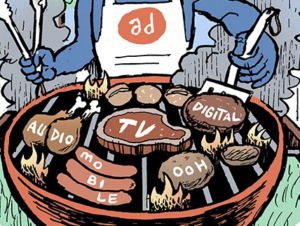Allison Lowrie is at home with data-driven marketing tactics.
As CMO of ANGI Homeservices, the IAC-owned parent of Angi (formerly Angie’s List), HomeAdvisor and Handy, Lowrie is helping the company infuse a performance mindset into how it approaches offline channels.
HomeAdvisor, which connects homeowners with home improvement professionals online, advertised during the Super Bowl for the first time this year. The brand is always looking for an opportunity to expand its reach, Lowrie said.
But she wasn’t about to spend more than $5 million – the going rate for a 30-second national spot during the big game – just to test out the value of adding a tentpole to the media plan.
Instead, she bought spots during the pregame broadcast and a local spot in the Denver market during the game, and measured the lift in traffic to the HomeAdvisor site within a five minute window of each airing. The results were encouraging, Lowrie said.
“A lot of people assume that when you do a major broadcast-type buy that the singular objective is to grow the brand and that performance goes out the window,” she said. “We just don’t look at it that way.”
AdExchanger spoke with Lowrie about the blurring line between brand and performance, in-housing and why she’s holding off on addressable TV, at least for the moment.
AdExchanger: How has ANGI’s marketing strategy evolved over the years?
ALLISON LOWRIE: I’ve been with the company since 2010, and at the time we didn’t really call it marketing, actually, we called it customer acquisition, because it was entirely transactional. There was no interest in building brand.
We’ve undergone a significant change, though, and started to broaden our marketing mix, particularly for the HomeAdvisor brand. We went from being highly concentrated on more traditional performance channels to a broader set of channels, including broadcast, radio, mobile app and content.
But our roots are still in data-driven performance marketing. With television, for example, we track the impact of every single impression we’re buying down to the station, daypart, individual airing and creative to see how they’re performing.
Why did you decide to try out the Super Bowl this year?
Home services is a massive category worth approximately $400 billion inclusive of the dollars customers spend for services and on products. But we see that only about 10% of the hiring activity for home services is happening online, meaning that nine out of 10 homeowners rely on a personal recommendation or word of mouth to find and hire service professionals.
How we approach media is reliant on that insight. Given that we’re in this land grab mode, our media strategy has been to adhere to core performance marketing principles to drive efficiency and to start to integrate opportunities and buys that help us dramatically expand our reach with homeowners we don’t reach through traditional DR-style media buys. The Super Bowl was a reach play, but we brought a digital-first mentality to it through A/B testing and mitigating our risk by doing a smaller local buy.
Where does addressable TV fit into your strategy?
The vast majority of our TV and offline media buying is happening in a traditional sense. We work through buyers at stations and networks. That said, we are starting to experiment with digital platforms and OTT, but we’re not buying a lot of it right now. That will change in the next two to three years given the precision of the targeting and the opportunity to find niche audiences. Right now, though, the hurdles are cost and the availability of inventory.
What about programmatic?
We buy direct from most publishers. We’re not using a DSP today, although that might change. For now we’re able to access the majority of inventory out there when we buy direct through Google and Facebook.
How do you vet your third-party technology partners?
We have a lot of homegrown technology resources to power our marketing. That’s not to say I’m opposed to integrating third parties, we just do it sparingly and where we think there’s significant value either in the form of driving efficiencies, like lower cost of acquisition, or getting access to inventory we’re missing today.
We have an agency for offline buying and targeted strategic agencies for niche components of digital buys, but the vast majority is in house, including paid search and affiliate relationships. Our goal, however, is to bring things like paid social and paid mobile app campaigns in house eventually.
What are you working on right now that has you excited?
We’re moving all our offline media buying in house, as well, which is a huge task, but we’re up for the challenge. We spend enough on TV and radio alone to have the buying power and capability to do it, and it will also help us expand our offline portfolio.
For example, today we’re not doing much direct mail, outdoor or other local offline media, but bringing those things in house would give us the ability to go out and negotiate better local deals which historically have been cost prohibitive.















